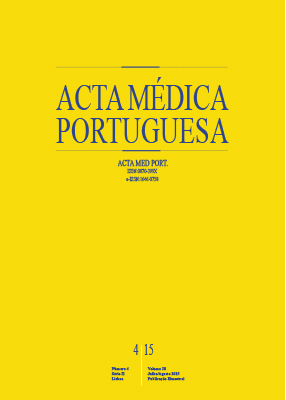Assessment of Suicidal Behavior in a Psychiatric Emergency Room in Lisbon,
DOI:
https://doi.org/10.20344/amp.5888Keywords:
Emergency Service, Hospital, Intention, Portugal, Questionnaires, Self-Injurious Behavior, Suicide, Attempted.Abstract
Introduction: Some studies alerted for the burden of suicidal attempters at emergency rooms. In this study we characterized the suicidal patients admitted to a Portuguese emergency room.
Material and Methods: For three years, all patients assessed by the first author after suicidal behaviour were included. Suicidal intentionality was evaluated with the Pierce Suicide Intent Scale. Clinical records were searched for follow-up status and satisfaction level was assessed through telephone call.
Results: From 120 included patients 70.8% were female, with mean age of 42.35 years. Pierce Suicide Intent Scale suicidal intentionality was low in 30.1%, medium in 59.3%, and high in 10.6% of the sample. The most important predictors of Pierce Suicide Intent Scale intentionality were male gender (p < 0.001), family history of suicide (p < 0.01), divorced or widowed marital status (p < 0.013), and severe mental illness (p < 0.015). In 41.6% of the patients the follow-up status was unknown. Regarding satisfaction, only 19.5% gave a valid answer: 2.7% ‘mildly satisfied’, 4.4% ‘moderately satisfied’, and 12.5% ‘very satisfied’.
Discussion: The Pierce Suicide Intent Scale is useful on suicidal behavior assessment at emergency rooms. Highly intentional suicidal behaviour is related to male sex, social problems and personal and familial psychiatric history.
Conclusion: The quality of administrative records on this psychiatric emergency room setting are still unacceptable. The most important variables correlated with higher suicidal intentionality are the same described in other countries. Of the reachable patients, one fifth was satisfied with provided follow-up. We still need studies for better understanding of suicidal behaviour observed on this Portuguese emergency room.
Downloads
Downloads
Published
How to Cite
Issue
Section
License
All the articles published in the AMP are open access and comply with the requirements of funding agencies or academic institutions. The AMP is governed by the terms of the Creative Commons ‘Attribution – Non-Commercial Use - (CC-BY-NC)’ license, regarding the use by third parties.
It is the author’s responsibility to obtain approval for the reproduction of figures, tables, etc. from other publications.
Upon acceptance of an article for publication, the authors will be asked to complete the ICMJE “Copyright Liability and Copyright Sharing Statement “(http://www.actamedicaportuguesa.com/info/AMP-NormasPublicacao.pdf) and the “Declaration of Potential Conflicts of Interest” (http:// www.icmje.org/conflicts-of-interest). An e-mail will be sent to the corresponding author to acknowledge receipt of the manuscript.
After publication, the authors are authorised to make their articles available in repositories of their institutions of origin, as long as they always mention where they were published and according to the Creative Commons license.









